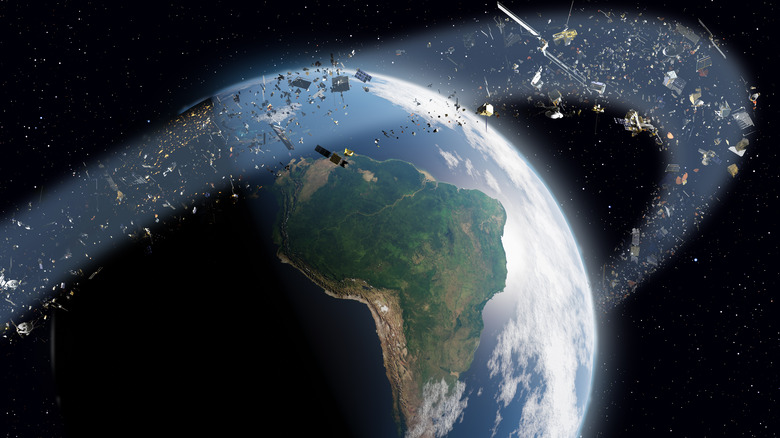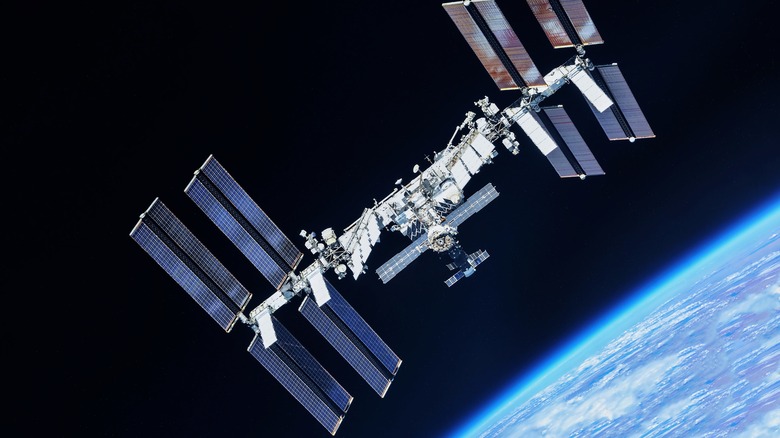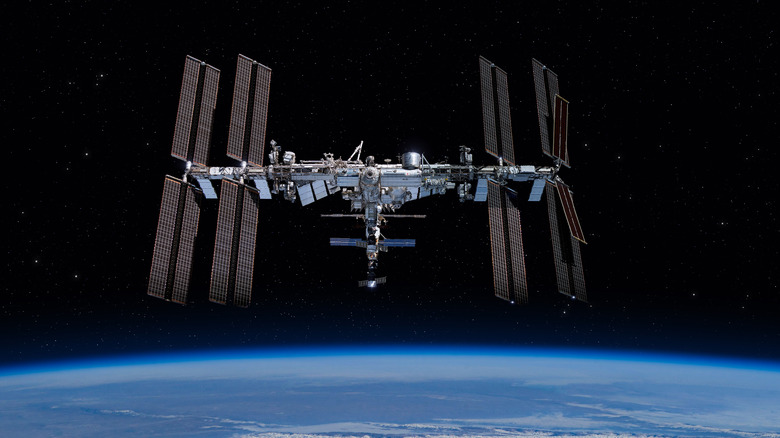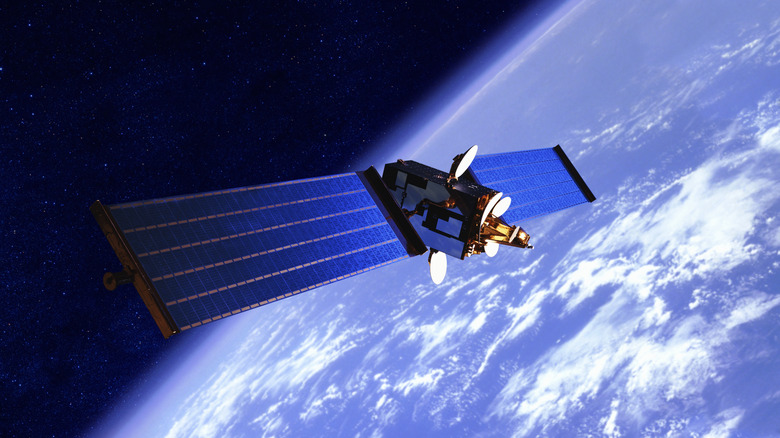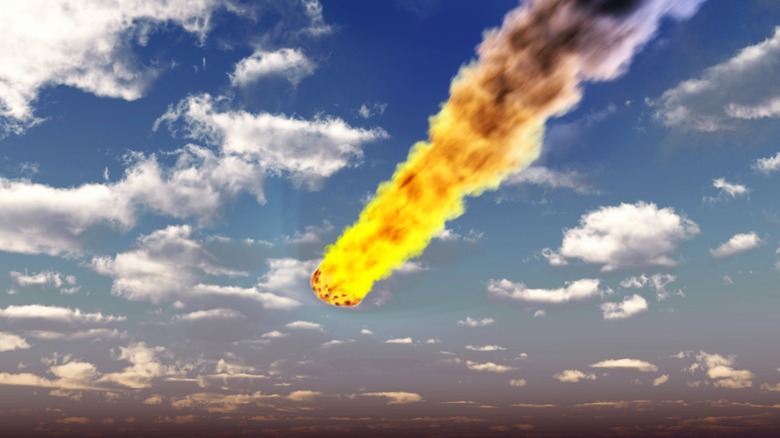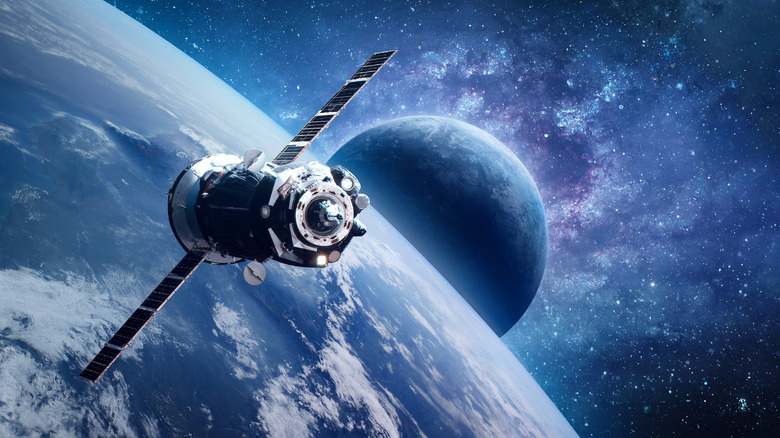5 Times Space Junk Almost Caused A Major Disaster
Space Junk is a problem few outside of the spaceflight industry consider, but it's a serious concern for us all. While you're highly unlikely to get hit in the head from falling space junk, there's a good chance the communications satellite you rely on to surf the Internet could be taken out by passing debris. Anything entering Earth's orbit runs a risk of leaving debris behind in the form of paint chips, loose bolts, tools, and more.
While a paint chip may not sound dangerous to anyone on Earth, an errant paint chip in orbit can be deadly. When we achieve a sustained orbit with something like the International Space Station (ISS), those objects zoom along at 17,500 mph. A paint chip dropped onto the floor does no harm, but a chip that flies into a spacecraft at 17,500 mph can severely damage or even destroy the vessel. It's happened to satellites, and many objects have run afoul of an errant piece of space junk.
Most pieces of space junk are incredibly small, though there are much larger pieces. In 2009, two satellites collided, destroying both, which put a ton of debris into orbit. Passing through that debris cloud can be deadly, so NASA and other agencies track what space junk they can. The space junk orbiting the planet includes around 3,000 inactive satellites and approximately 34,000 pieces of junk that measure larger than four inches, with millions of smaller pieces threatening anything intentionally put into orbit.
Chinese satellite debris nearly hit the ISS in 2021
The International Space Station is big — really big. It's the largest object we've put into orbit, and it shows. The ISS weighs nearly one million pounds and is 293 feet by 258 feet long, which is about the same size as an American football field. It's also a big target that finds itself threatened by space junk more often than the folks working inside its pressurized modules would like. In 2021, the ISS came under threat from the debris from a Chinese satellite.
In November 2021, the crew of the ISS had to maneuver the space station out of the way of some dangerous space junk. The urgent change of orbit occurred on November 11 in response to a potential collision with pieces of the defunct Fengyun-1C weather satellite. The same satellite the Chinese destroyed in a 2007 demonstration of its anti-satellite missile system. The explosion resulted in around 3,500 pieces of debris, many of which have fallen into the ISS' orbit.
The demonstration resulted in the largest-ever debris field in space, so it posed a serious problem. That demonstration nearly cost the world its ISS years later. Of course, it's not the only time the ISS has run afoul of space junk. In May 2021, a mote of space debris slammed into the ISS' robot arm, punching a 5 mm hole through it. Sadly, the change of orbit in 2021 wasn't the last time the space station was threatened.
A Russian satellite nearly took out the ISS in 2024
The International Space Station came under threat from satellite debris again in 2024, and this time, the crew was at serious risk. In June 2024, a defunct Russian satellite broke up in orbit, releasing around 100 pieces of debris. This posed a problem for the ISS and its crew, which was forced to take shelter for an hour within the space station out of fear it would be struck. Taking shelter in this manner isn't about avoiding explosions like in the film "Gravity."
The astronauts aboard the ISS took shelter to minimize the risk of decompression that could be caused by a tiny piece of space junk penetrating the hull. The six astronauts sheltered in their respective spacecrafts, making it possible to depart should the need arise. It's unclear what caused the RESURS-P1 Russian Earth observation satellite to break up in orbit, though the spacecraft was declared defunct by Russia in 2022 and was effectively a large piece of space junk in and of itself.
As soon as the satellite broke up, Earth-based space-tracking radars picked up over 100 pieces, so they were relatively large, measuring four inches and larger. The U.S.-based space-tracking firm LeoLabs detected more, finding 180 pieces the following day. Fortunately, the debris cloud was in Low Earth Orbit (LEO), so LeoLabs estimated that it could take a few months before the hazard no longer threatened the ISS.
Soviet rocket debris nearly took out a military satellite in 2023
One of the biggest dangers posed by large objects orbiting the planet is that they'll break up into smaller ones with erratic trajectories. A large object can be tracked more easily than smaller ones, and it's possible to determine the path it will take. When these pieces of large debris break apart, some debris remains on the same trajectory, but others shoot off in various directions and speeds. These are harder to track and very dangerous for anyone or anything in orbit.
While the world can decry a country for shooting one of its defunct satellites, that cannot be said of accidental collisions. There was nearly a massive one in 2023, thanks to a Soviet SL-8 rocket body that's been traveling around the planet for decades. The rocket body nearly collided with a military satellite. While that would have caused disruptions to military operations, the true threat would have been the massive cloud of debris caused by the collision.
The near miss occurred at 611 miles above the surface of the earth in LEO. According to LeoLabs, that altitude, and much of LEO is littered with space junk. The company has identified around 160 SL-8 rocket bodies and around 160 payloads, all flinging around the planet. LeoLabs explained on X, formerly known as Twitter, that this kind of collision is a "worst-case scenario" because there's nothing anyone can do but watch two defunct objects approach one another and hope for the best.
Space debris nearly killed a kid in 2024
There are thousands of dangerous objects orbiting the planet, but most are threats to other spacecraft, not people on the ground. That's because most objects burn up when they enter the Earth's atmosphere. Still, not everything breaks apart, and some items find their way onto the surface. Still, it's incredibly unlikely a person could be hit, as most of the planet is covered in water, and people occupy a surprisingly small percentage of the Earth's surface: around 10%.
Still, a person's chance of getting hit by falling space debris isn't zero, and in 2024, a close call almost cost a child their life. In March 2024, a man in Naples, Florida, Alejandro Otero, was shocked when a piece of space debris believed to have come from the ISS crashed into his home. Not only did the space junk crash into his home, but it came incredibly close to hitting Otero's son. Mr. Otero recounted the harrowing event in an interview with WINK News:
"I was shaken, I was completely in disbelief — what are the chances of something landing on my house with such force to cause so much damage?" Otero's home was severely damaged by a metal cylinder about four inches in length and diameter. U.S. Space Command recorded the reentry only five minutes before it struck, and while it's difficult to determine its origin, it likely came from a 2.9-ton EP-9 pallet the ISS astronauts discarded in March 2021.
A Russian satellite almost hit a NASA spacecraft in 2024
In February 2024, NASA's Thermosphere Ionosphere Mesosphere Energetics and Dynamics Mission (TIMED) came frighteningly close to colliding with the Russian Cosmos 2221 satellite. NASA launched the TIMED satellite in 2001, while the Cosmos 2221 was launched in 1992 but is now defunct. NASA issued an urgent alert as the two objects came close to one another, while analysts out of LeoLabs described the near miss as being "too close for comfort."
Initially, it was believed that the Cosmos came within around 65 feet of one another. That may not sound close on Earth, but in space, that's basically intimate! What's worse is that the initial assessment was off by a lot. Later analysis of the near miss determined that the Russian satellite came within 33 feet of the TIMED. NASA Deputy Administrator Pam Melroy provided details during a presentation at the 39th Space Symposium in Colorado Springs:
"We recently learned through analysis that the pass ended up being less than 10 meters apart — within the hard-body parameters of both satellites." She also mentioned how the close encounter "really scared us all." Had they collided, they would have generated a significant debris field, traveling thousands of miles per hour. Fortunately, they didn't collide, and each object continued on their respective trajectories. The event illustrates the dangers posed by derelict spacecraft as well as space junk.
